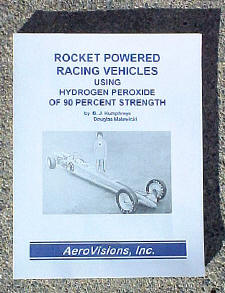Hydrogen Peroxide Rocket power was used on the infamous Messerschmitt ME-163 Rocket plane of World War II. The USA's research ship, the X-15, also used Hydrogen Peroxide to first bring humans to the fringes of outer space (for both the reaction control system and for turbo pump power for the main engines). The propellant is not all that powerful (only about 30% of the thrust per pound that liquid hydrogen/oxygen provides), but it is much more safe and non-toxic compared to the more exotic propellants. The real advantage to using Hydrogen Peroxide is that it's decomposition temperature is only 1,370 degrees Fahrenheit, so the rocket motor catalyst pack and nozzles can be made with ordinary stainless steels.
The systems can easily be built by any skilled machinist. No exotic metals, no clean rooms, no high tech chemical milling, etc. This led to a proliferation of Rocket Powered Drag Racers 20 years ago. They went so fast, so easy that for spectator safety the National Hot Rod Association imposed 300 MPH speed limits and fines for exceeding 300 MPH!
It is technically feasible to build a dragster to go supersonic from a standing start in a quarter mile (761 MPH - if the temperature at the time is 59 degrees Fahrenheit). One needs to just put a 25,000 pound thrust hydrogen peroxide rocket motor into a 1,000 pound racing vehicle that carries 2.36 seconds worth of fuel (472 pounds). The real problems to be solved would be cushioning the human driver to take 14.7 g's for the 2.36 seconds it would take to cover the quarter mile from a standing start. You would also have to worry about controlling the beast down the strip AND more importantly how to get it stopped safely. Not enough room at the typical dragstrip - one would probably be safer to have it transition into a more or less airplane and pull it up after the quarter mile point. Then, after it coasted up some three miles, instead of trying to dead stick land it like astronauts do with the Space Shuttle Orbiter, just pop some chutes to bring it back safely for the next qualifying run!
Also, if something bothered you when reading about the supersonic dragster idea, check the math out yourself and Email me with at least two parameters that need to be changed or considered to make such an idea more realistically feasible. Include an explanation of your thinking. The first person under 21 years of age (the real rocket scientists out there should catch it all instantly - so that isn't fair) who comes reasonably close to a good explanation gets a free Hydrogen Peroxide book. Anyway, don't believe everything just because you see it in print! Gotcha!
(This challenge was finally addressed in a mathematically correct manner by by Jonny Dyer, age 16 of San Antonio, Texas. His free H2O2 book went out to him on September 14, 1998. Congratulations Jonny!
There will be no more prizes for the correct answer, but I will still respond to anyone interested in EMailing me their rational/critique of the above concept.)
Way back in 1974, I co-authored a book on the subject of "Rocket Powered Racing Vehicles Using 90% Strength Hydrogen Peroxide" with a wonderful gentleman, Jim Humpheys. Jim, who passed away several years ago, suffered from muscular dystrophy most of his adult life. He was always a rocket nut and didn't let the disease slow him down. He actually build a rocket powered wheel chair and Jim's ultimate speed record for the world's fastest rocket powered wheel chair still stands! The technology of Hydrogen Peroxide Rockets hasn't changed in the interim, so all the information is still valid. The book is 100 pages long with tons of photos, drawings, schematics and sketches. If this kind of thing interests you, put one in your shopping cart.
(Please note that the book is archival. Jim's wife, Nicky, could not find any of Jim's original book masters or original photos for me. Thus, the books offered here are second generation machine copies of a printed book and are not up to original printed from masters quality. I have enlarged the original 5" by 8" pages to 8" by 11.5" which helps readability a lot. If you order one and are dissatisfied, return it for a full refund. Doug Malewicki)
The above drawing from the book is a step towards a Zero to Supersonic in the quarter mile dragster that goes airborne at the end of the run whenever stopping room is limited.
|
100 pages of
information on Hydrogen Peroxide Rocket Powered racing vehicles |
"Rocket Powered Racing Vehicles Using 90% Strength Hydrogen Peroxide" sells for $29.95 plus shipping and handling.
GO TO THE CanoSOARus.com ORDER PAGE
Other good technical sources on rockets are:
1.
The Rocket Reaction Society (RRS), the oldest continuous
operating amatuer experimental rocket group in the United States. They build and launch
some heavy duty serious liquid and solid propellant rockets from their Mojave Test Area in
the California desert. I am a member of the RRS.
2.
The American Institute of Aeronautics and Astronautics
(AIAA) which is a technical society delving into all things flying in and out of the
atmosphere. I am currently a senior member in the AIAA and have been a member since I was
a college student at the University of Illinois.
Of special interest to High School students with an intense interest in rockets and space
exploration is the AIAA sponsored SPACE
SETTLEMENT DESIGN COMPETITION. "SPACESET" started with students
getting to spend a weekend at the Jet Propulsion Lab (JPL) in Pasadena and now has become
international in scope with finalist's spending
time competing as design proposal teams at Kennedy Space Center in Florida.
3.
The Tripoli Rocketry Association which is the best
source for information on large scale rocketry which only permits rocket flights
using commercially available solid propellant motors.
